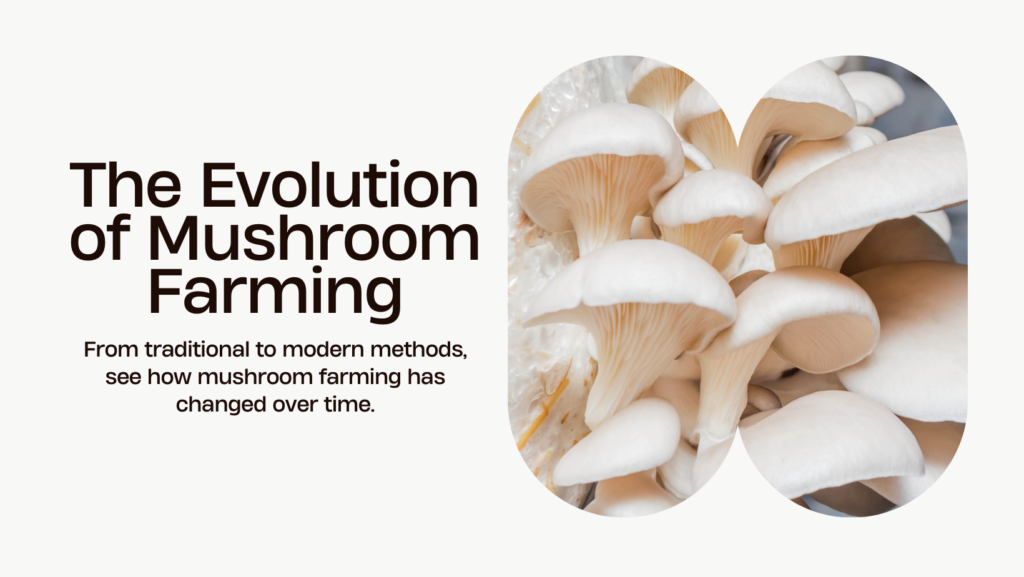
Are you curious about the fascinating world of mushroom farming? Mushroom farming has taken on a new importance as a sustainable food production method. This has led to an evolution of techniques and methods over the years. From traditional methods to modern innovations, the industry has come a long way.
In this article, we will explore the history of mushroom farming and how it has evolved over time. We will discuss the traditional methods that were once commonly used and how technological advancements have revolutionized the industry. We will also explore modern approaches and discuss how they are being used to overcome challenges and adopt sustainable practices.
Key Takeaways
- Mushroom farming has evolved over time, from traditional methods to modern innovations.
- Technological advancements have revolutionized the industry, leading to improved yield and quality.
- Modern approaches, such as indoor vertical farming and sustainable practices, are being adopted to overcome challenges.
- The potential for growth in mushroom farming is significant, with emerging trends and potential future innovations in the field.
Overview of Mushroom Farming and Its Significance
Mushroom farming is a sustainable agricultural practice that has gained significant importance in recent years. As a method of food production, it offers several benefits, including efficient use of resources, minimal environmental impact, and year-round availability of high-quality mushrooms.
Mushroom farming has a rich history, dating back to ancient China. Over the years, it has evolved into a modern practice that involves the use of technology and advanced techniques to maximize yields and produce high-quality mushrooms.
One of the most significant factors contributing to the growing popularity of mushroom farming is its ability to meet the rapidly increasing demand for nutritious and delicious food worldwide. Edible mushrooms are a rich source of essential nutrients such as protein, vitamin D, and antioxidants, making them a popular choice among health-conscious consumers.
Mushroom farming is also an eco-friendly alternative to traditional forms of agriculture. For instance, mushroom cultivation can be undertaken without the need for arable land, which is not the case with most other crops. Instead, mushrooms can be grown using a variety of waste materials such as straw, sawdust, and agricultural crop residues. This process helps to reduce greenhouse gas emissions and promote sustainable land use.
Overall, mushroom farming is a significant and sustainable food production method that offers several benefits, ranging from efficient resource management to year-round availability of high-quality mushrooms. As demand for nutritious and delicious food continues to rise worldwide, mushroom farming is set to play an increasingly important role in meeting these requirements.
Traditional Methods of Mushroom Farming
An aerial view of a traditional mushroom farm surrounded by lush trees and greenery. The farm features small wooden huts with thatched roofs and rows of mushroom beds made of composted straw and manure. In the distance, workers can be seen tending to the mushrooms, using shovels to turn the soil and buckets to water the beds. The colors are warm and earthy, with hints of yellow, green, and brown throughout the image.
Mushroom farming has a rich history, with traditional methods that were used for centuries before modern innovations took over. Manual cultivation was the most common traditional method for mushroom farming. Many families used to cultivate mushrooms in their backyards, creating their own substrate and maintaining the ideal temperature and humidity conditions for optimal mushroom growth.
In traditional mushroom farming methods, the substrate was prepared using natural materials, including straw, horse manure, and chicken manure. The use of organic substrates was prevalent in traditional mushroom farming as these materials are readily accessible, cost-effective, and sustainable. It is interesting to note that the natural process of straw and manure decomposition releases heat, which was used to sustain the temperature required for the ideal growth of the fungal mycelium.
Traditional practices of mushroom farming required immense attention to detail as any deviation from the ideal growing conditions could affect the quality and yield of the crop. Mushroom growing was often a family activity where everyone was involved in the process of cultivating, harvesting, and packaging. This not only provided a source of income for the family but also helped them maintain a balanced diet by including fresh produce in their meals.
The traditional methods of mushroom farming laid the foundation for modern-day practices. Today, the mushroom industry has evolved significantly with the incorporation of innovative technology, scientific methods, and sustainable practices.
Advancements in Mushroom Farming Techniques
Over the years, mushroom farming has undergone significant changes due to technological advancements. These innovations have led to an increase in yield, improved quality, and enhanced sustainability in the industry.
Improved Management and Monitoring Systems
New sensor technologies have allowed for the better monitoring and management of growing conditions, ensuring optimal growth and development of mushrooms. Automated climate control systems have made it possible to maintain stable temperature and humidity levels, leading to better crop performance and yield.
Introduction of Modern Substrate and Spawn Production Techniques
The use of modern substrate and spawn production techniques has led to more efficient and sustainable mushroom farming. This includes the use of advanced sterilization and inoculation methods to improve the quality of the spawn. The production of nutrient-rich substrates has also resulted in better crop yields.
Innovative Lighting Systems for Mushroom Cultivation
Lighting plays a significant role in mushroom farming as it affects the growth and development of the crop. Innovative LED lighting systems have been introduced to the industry, allowing for customized light wavelengths and intensity that enable optimal growth and development of mushrooms.
Introduction of Cloud-Based Management Systems
The introduction of cloud-based management systems in mushroom farming has led to improved efficiency and sustainability in the industry. These systems allow for real-time monitoring of growing conditions, tracking of crop performance indicators, and remote controlling of climate and lighting systems, leading to reduced energy consumption and improved crop yields.
“The use of modern technologies and innovative practices has revolutionized the mushroom farming industry, leading to improved yields, better quality, and a more sustainable approach to food production.”
Introduction of Controlled Environment Agriculture in Mushroom Farming
Controlled environment agriculture (CEA) has had a significant impact on mushroom farming in recent years. By ensuring optimal growing conditions, it has revolutionized the field, leading to higher yields and better quality crops. CEA refers to the practice of growing crops in an enclosed environment with controlled parameters, such as temperature, humidity, and lighting, that are conducive to the plant’s growth.
This technique has proven to be particularly effective for mushroom farming, where maintaining consistent environmental conditions is crucial to successful cultivation. In a controlled environment, it is easier to ensure that the mushrooms grow under ideal conditions, producing a higher quality fruiting body that is free from diseases and pests.
One of the primary advantages of CEA in mushroom farming is that it can be used to grow mushrooms year-round, regardless of the outside conditions. This has made it possible for growers to produce crops in any region, regardless of climate, resulting in a more reliable and stable production cycle.
Another benefit of CEA is its ability to produce crops using fewer resources and lower land use, making it a more sustainable option for food production. This technology also enables growers to cultivate mushrooms in smaller spaces, maximizing the use of available land while increasing yield.
With the continued development of CEA technology, the future of mushroom farming looks bright. Innovations in lighting, nutrient delivery, and automation are making it easier and more efficient to cultivate mushrooms in controlled environments. By embracing these advances, mushroom farmers can ensure a stable supply of high-quality mushrooms while minimizing their impact on the environment.
Innovations in Substrate Preparation for Enhanced Mushroom Cultivation
A detailed illustration of the process of mixing and sterilizing the substrate using modern machinery. Show the various stages of preparation, including measuring ingredients, blending, and heating. Use warm colors to convey a sense of growth and vitality. Capture the complexity and intricacy of the equipment used in this cutting-edge process.
If you’re looking to maximize your mushroom yield, one of the most critical factors to consider is substrate preparation. Over the years, growers have developed several innovative techniques to create the perfect growing medium, thus improving the overall quality and quantity of their crops.
One of the most significant innovations in substrate preparation in mushroom cultivation is the use of pre-sterilized ready-to-use substrates. This solution eliminates the labor-intensive preparation process and reduces the risk of contamination.
Another popular approach is steam sterilization, which uses high-pressure steam to sterilize the substrate and eliminates unwanted organisms that can harm your mushroom cultivation. Steam sterilization is effective in producing high yields and consistent results.
Alternatively, growers can also use pasteurization to sanitize the substrate. This method involves heating the substrate to a lower temperature compared to steam sterilization, making it ideal for sensitive substrates. However, pasteurization requires more time and attention, and its effectiveness depends on the pasteurization time and temperature.
To further enhance mushroom growth, growers can also incorporate additional nutrients to the substrate. For example, some growers add grains or other organic materials to enrich the substrate with carbohydrates and other essential nutrients in addition to the mushroom spawn.
Overall, by utilizing innovative substrate preparation techniques, growers can enhance mushroom growth and yield, leading to a more profitable and sustainable mushroom farming operation.
Modern Approaches to Mushroom Cultivation
Advancements in technology have transformed traditional mushroom farming methods. With modern approaches, mushroom cultivation has become more efficient and sustainable. In this section, we will explore some of the emerging modern approaches in mushroom cultivation.
Indoor Vertical Farming Systems
Indoor vertical farming systems are a recent innovation in mushroom cultivation. These systems involve growing mushrooms in stacked layers, maximizing the use of space. The controlled environment of this growing method reduces the likelihood of pests and diseases while also providing consistent growing conditions. With the vertical farming system, it is possible to produce a higher yield than with traditional farming methods.
Use of Advanced Technology for Monitoring and Regulating Growing Conditions
The use of advanced technology has made it possible to monitor and regulate temperature, humidity, and lighting conditions during mushroom cultivation. Sensors can detect any environmental changes, and automated systems can adjust the growing conditions in real-time. This technology ensures that the growing conditions are optimal, resulting in a higher mushroom yield and better quality produce.
Sustainable Practices
In addition to technological advancements, sustainable practices are also being adopted in mushroom cultivation. The use of organic farming methods and renewable energy sources, such as solar-powered systems, are becoming more common. These practices reduce the carbon footprint of mushroom farming while also promoting sustainable agriculture.
“The modern approaches in mushroom cultivation have not only improved yield and quality, but they have also contributed to the sustainability of the industry.”
Addressing Challenges and Adopting Sustainable Practices in Mushroom Farming
Farming mushrooms can pose a variety of challenges, from unpredictable weather conditions to pests and diseases. However, the industry is constantly evolving, and farmers are adopting sustainable practices to address these challenges.
One sustainable practice that has gained popularity is organic farming. Organic farming methods prioritize the use of natural fertilizers and pesticides, reduce environmental pollution, and produce healthier mushrooms.
Another practice that has proven effective is the use of renewable energy sources. Many mushroom farms are now implementing solar or wind power technology to reduce their carbon footprint and save money in the long run.
“Sustainability and profitability go hand in hand in mushroom farming. By implementing sustainable practices, we not only contribute to a healthier planet but also ensure the longevity of our business.” – Mary Smith, Mushroom Farmer
To showcase the impact of sustainable practices, take a look at the table below:
| Challenge | Sustainable Solution | Impact |
|---|---|---|
| Pests and diseases | Organic farming methods | Reduced reliance on harmful pesticides and fertilizers |
| High energy usage and carbon footprint | Use of renewable energy sources | Reduced energy costs and carbon emissions |
| Waste management | Implementation of a waste management system | Reduction of waste and contribution to a circular economy |
Adopting sustainable practices not only helps to address the challenges faced in mushroom farming but also contributes to the industry’s growth and future sustainability.
FAQ
Q. What is mushroom farming?
A. Mushroom farming is the cultivation of mushrooms for commercial purposes. It involves creating and maintaining optimal growing conditions for various mushroom species to ensure high yield and quality.
Q. Why is mushroom farming significant?
A. Mushroom farming plays a crucial role in sustainable food production. Mushrooms are a nutritious food source and can be cultivated year-round. Additionally, mushroom farming promotes biodiversity, recycling of organic waste, and utilization of marginal land.
Q. What were the traditional methods of mushroom farming?
A. Traditional methods of mushroom farming relied on manual cultivation, natural substrate selection, and open-air mushroom houses. Farmers would typically select mushroom species that grew naturally in their region and use organic materials as the substrate.
Q. What advancements have been made in mushroom farming techniques?
A. Technological advancements have revolutionized mushroom farming. Automated systems for temperature and humidity control, artificial lighting, and innovative substrate preparation methods have led to higher yield, consistent quality, and reduced risk of contamination.
Q. How does controlled environment agriculture impact mushroom farming?
A. Controlled environment agriculture, with regulated temperature, humidity, and lighting, provides optimal growing conditions for mushrooms. This method minimizes external factors that can affect growth, improves yields, and allows for year-round cultivation.
Q. What are the innovations in substrate preparation for enhanced mushroom cultivation?
A. Innovations in substrate preparation include the use of sterilization techniques, such as steam pasteurization and chemical disinfection, to eliminate contaminants. Additionally, advanced formulations and techniques for preparing the substrate have been developed to enhance mushroom growth.
Q. What are the modern approaches used in mushroom cultivation?
A. Modern approaches to mushroom cultivation include the use of indoor vertical farming systems, advanced technologies for monitoring and regulating growing conditions, and sustainable practices such as organic farming methods and the use of renewable energy sources.
Q. How are challenges like pests, diseases, and market demand addressed in mushroom farming?
A. Challenges in mushroom farming are addressed through integrated pest management strategies, disease prevention measures, and market research. By implementing sustainable practices and adopting organic farming methods, farmers can mitigate the risks and meet market demand.
Q. What are the future trends and potential innovations in mushroom farming?
A. The future of mushroom farming holds potential for further technological advancements, such as AI-powered monitoring systems, genetic engineering for improved mushroom varieties, and innovative packaging solutions. These developments aim to increase efficiency, sustainability, and market competitiveness.
Conclusion
Now that you have explored the evolution of mushroom farming from traditional methods to modern innovations, you have a better understanding of this important industry. Mushroom farming has come a long way, thanks to advancements in technology and innovative approaches.
Looking to the future, the mushroom farming industry shows no signs of slowing down. Emerging trends such as the use of biotechnology and precision farming are expected to drive growth and innovation in the industry. As demand for sustainable and locally sourced food continues to rise, mushroom farming is poised to become an increasingly important player in the world of food production.
Whether you are a seasoned mushroom farmer or someone interested in getting started in this exciting field, it is clear that mushroom farming will play an important role in the future of food production. So, stay tuned for more exciting developments in this ever-evolving industry!
















